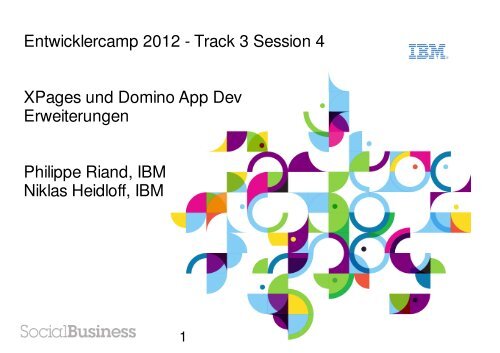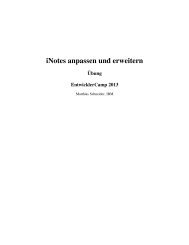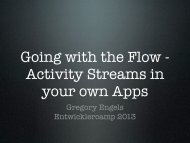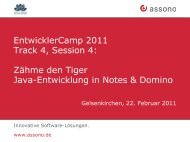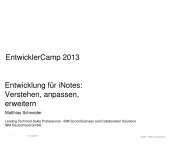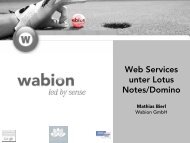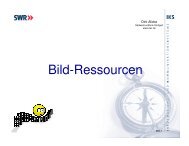T3S5-Domino OSGi Development - EntwicklerCamp
T3S5-Domino OSGi Development - EntwicklerCamp
T3S5-Domino OSGi Development - EntwicklerCamp
- No tags were found...
You also want an ePaper? Increase the reach of your titles
YUMPU automatically turns print PDFs into web optimized ePapers that Google loves.
Entwicklercamp 2012 - Track 3 Session 4XPages und <strong>Domino</strong> App DevErweiterungenPhilippe Riand, IBMNiklas Heidloff, IBM1
Disclaimer The information contained in this publication is provided for informational purposes only. While efforts were made to verify thecompleteness and accuracy of the information contained in this publication, it is provided AS IS without warranty of any kind, expressor implied. In addition, this information is based on IBM’s current product plans and strategy, which are subject to change by IBMwithout notice. IBM shall not be responsible for any damages arising out of the use of, or otherwise related to, this publication or anyother materials. Nothing contained in this publication is intended to, nor shall have the effect of, creating any warranties orrepresentations from IBM or its suppliers or licensors, or altering the terms and conditions of the applicable license agreementgoverning the use of IBM software. References in this publication to IBM products, programs, or services do not imply that they will be available in all countries in whichIBM operates. Product release dates and/or capabilities referenced in this presentation may change at any time at IBM’s solediscretion based on market opportunities or other factors, and are not intended to be a commitment to future product or featureavailability in any way. Nothing contained in these materials is intended to, nor shall have the effect of, stating or implying that anyactivities undertaken by you will result in any specific sales, revenue growth or other results. All customer examples described are presented as illustrations of how those customers have used IBM products and the results theymay have achieved. Actual environmental costs and performance characteristics may vary by customer. IBM, the IBM logo, Lotus, Lotus Notes, Notes, <strong>Domino</strong>, DeveloperWorks and Workplace are trademarks of International BusinessMachines Corporation in the United States, other countries, or both. Java and all Java-based trademarks are trademarks of Sun Microsystems, Inc. in the United States, other countries, or both All references to Renovations refer to a fictitious company and are used for illustration purposes only. Other company, product, or service names may be trademarks or service marks of others.
Agenda Access to relational Databases from XPages JDBC Driver to access NSFs <strong>Domino</strong> REST APIs Workflow for XPages <strong>OSGi</strong> Tasklet Service3
Agenda Access to relational Databases from XPages JDBC Driver to access NSFs <strong>Domino</strong> REST APIs Workflow for XPages <strong>OSGi</strong> Tasklet Service4
XPages Extension Library OpenNTF Available at http://extlib.openntf.org/– Active conversation with developers in the Discussions and Defects section5
XPages Extension Library OpenNTF There are 2 sets of plugins included in OpenNTF delivery– “extlib” and “extlibx”. Each set is wrapped into its own XPages specific library– com.ibm.xsp.extlib.library– com.ibm.xsp.extlibx.library The “extlibx” library contains eXperimental code– RDBMS support– Social Enabler and others Experimental code can get added to the “extlib” library– once the code has matured and there is sufficient customer demand6
XPages Extension Library OpenNTF XPages apps can depend on both the extlib and extlibx libraries– RDBMS access requires both dependencies7
XPages Extension Library Demo App XPagesJDBC.nsf– SQL table data and sorting– SQL query data– SQL query with count and page navigation– SQL query data when query is in a file– SQL parameterized queryDEMO8
New XPages Data Sources for RDBMS XPages leverages JDBC when connecting to relational databases– Accesses any database with a JDBC driver available– You could access• DB2,• Oracle,• MS SQL,• MySQL,• Derby• ... you name it!– You need to obtain the JDBC driver from the database vendor or third party provider RDBMS data is accessed directly – no synchronization is performed with NSF XPages efficiently manages the connections through a connections pool Uses NSF specific connections The data is accessed using a set of dedicated data sources9
New XPages Data Sources for RDBMS extlibx library adds 2 new data sources:– JDBC Query for Read Only access– JDBC RowSet for CRUD (create/read/update/delete) access.• Current implementation is based on com.sun.rowset.CachedRowSetImpl,• Could be configured to use your own via the rowSetJavaClass property Each of the provided new datasources could be easily utilized eitherby:– the core View Container Control(xp:viewPanel element)– the XPage itself (xp:viewelement) The new data sources are nowavailable in the <strong>Domino</strong> DesignerProperty Panel10
New XPages Data Sources for RDBMS It's very easy to bring your relational data into an XPages enabled web application using familiar <strong>Domino</strong> Designercontrols12
New XPages Data Sources for RDBMS For the CRUD scenario – you could easily develop a record editing dialog, taking values from the JDBC RowSetdata source13
XPages Extension Library Demo App DEMO of the <strong>Domino</strong> Designer view control configuration, with the new JDBC data sources:– JDBC Query usage– JDBC RowSet usage14
Making RDBMS Connections To connect to your RDBMS you need to create a special file resource– .jdbc extension (for example “db2test.jdbc”)• Specifies the JDBC driver class to be used• The database host/port/name and users' credentialscom.ibm.db2.jcc.DB2Driverjdbc:db2://testvm:50000/SAMPLEdemotest123• The file name before the “.jdbc” extension is the connection name (in this case “db2test”)– Should be used in the JDBC data sources configuration File resources with the “.jdbc” extension– Should be placed within an XPages application (NSF)under the WebContent/WEB-INF/jdbc folder– This folder is visible within <strong>Domino</strong> Designer in the Navigator/Package Explorer views only.– It is not visible in the default Applications view File resources within the WebContent/WEB-INF– Cannot be accessed via URL syntax– Your password and connection data is secure15
Making RDBMS Connections SQL data can be made available by using the following properties:– sqlTable (the runtime will generate a select * from )– sqlQuery (SQL query, which could be either static or computed)– sqlFile (file resource with the “.sql” extension, containing the SQL statement) The Core Pager control (xp:pager) can be used to navigate through the SQL data and additional properties can helpdisplay the actual number of pages for the JDBC Query data source:– calculateCount (false by default, but when set to true, the runtime will generate select count(*) for thecorresponding table or query)– sqlCountQuery (allows you to specify your own count query)– sqlCountFile (file resources with the “.sql” extension, containing the SQL count query) For the JDBC RowSet data source, you could limit the number of rows retrieved by:– maxRows (default is 0, all rows retrieved, so be careful here)– Pager control is already aware of the actual number of pages File resources with the “.sql” extension should be placed in an XPages application, under the WebContent/WEB-INF/jdbc folder.16
Making RDBMS Connections SQL query could be parameterized using the '?' syntax– select * from users where state=? Each corresponding parameter can be defined using the sqlParameters data source property and this can also becomputed17
Making RDBMS Connections For your SQL queries and DB2 RDBMS you can:– Call User Defined Functions (UDF) using the special sysibm.dual table– Refer query fields by using aliases18
Making RDBMS Connections The use of these various properties are demonstrated in the included XPagesJDBC.nsf demo application DEMO of the additionalXPagesJDBC.nsf applicationcapabilities:– Programming aspects– @Functions usage19
Server Side JavaScript APIs and @Functions Currently implemented @Functions:– @JdbcInsert– @JdbcUpdate– @JdbcDelete– @JdbcExecuteQuery– @JdbcDbColumn– @JdbcGetConnection Used to simplify various RDBMSoperations Allows programmatic access to RDBMS data20
Server Side JavaScript APIs and @Functions @JdbcInsert function has now an additional calling prototype, which allows you to take advantage of the RDBMStable autoincrement/identity field:21
Server Side JavaScript APIs and @Functions @JdbcExecuteQuery can be used for quick RDBMS data retrieval and additional processing inside your XPage @JdbcDbColumn can be used to populate, for example, an XPages combobox control, with the RDBMS table fields'values22
Server Side JavaScript APIs and @Functions To access a row in the JDBC data source, inside an xp:viewPanel, you need:– an index variable specified via the indexVar property, for example, 'idx'– usage of the data source getRow(int index) method, for example, #{javascript:jdbcData1.getRow(idx)}, for some event processing Changes to the JDBC RowSet data source could be saved back to the RDBMS using:– #{javascript:jdbcData1.acceptChanges()} syntax23
Setup of Server/<strong>Development</strong> Environments If you have Upgrade Pack 1 previously installed – you need to uninstall it To consume RDBMS data, you need to install the OpenNTF version of the XPages Extension Library, Since the OpenNTF version doesn't have an installer, like the UP1 installer, you need to follow these steps:– Download the latest ExtensionLibraryOpenNTF-853-YYYYMMDD-HHMI.zip file (it's big!)– Unzip that big zip updateSiteOpenNTF.zip file (to be installed on the <strong>Domino</strong> server/Notes preview server)– Unzip all the content in the updateSiteOpenNTF.zip file, so you can access the site.xml, as well as the features/plugins folders– Unzip, from the big zip, the updateSiteOpenNTF-designer.zip file (to be installed in <strong>Domino</strong> Designer)– No need to unzip the updateSiteOpenNTF-designer.zip content24
Setup of server/development environments Installation on the <strong>Domino</strong> server should be done using the XPages Extension Library Deployment in <strong>Domino</strong>8.5.3 and IBM XWork Server technique described in the Lotus Notes and <strong>Domino</strong> Application <strong>Development</strong> wiki:– Involves creation of a new NSF application based on the updatesite.ntf template and import of the extractedupdateSiteOpenNTF.zip content, using its site.xml file– Requires specification of an OSGI_HTTP_DYNAMIC_BUNDLES variable inside your server's notes.ini file topoint to the update sites' NSF– Uses additional safeguards when loading plugins (ACL) Installation for Notes web preview (where no <strong>Domino</strong> server is running) should be done based on the Using anXPages Library in Designer technique, which is also described in the Lotus Notes and <strong>Domino</strong> Application<strong>Development</strong> wiki:– Requires the features/plugins folder content, which was previously extracted from updateSiteOpenNTF.zip, tobe merged with the existing features/plugins folders found under the \domino\workspace\applications\eclipse folder– Special attention should be taken not to use, for Notes web preview purpose, another similar looking folder\workspace\applications\eclipse, whose purpose is to provide features/plugins for the Notesclient/<strong>Domino</strong> Designer functionality25
Setup of server/development environments In order for the <strong>Domino</strong> server to load these installed plugins, you need to restart your <strong>Domino</strong> server, issuing theconsole command restart task http To verify the plugins for the extlib and extlibx XPages libraries are properly installed - you should use the OSGIcommand on the server console:tell http osgi ss com.ibm.xsp.extlib26
Setup of server/development environments An additional plugin/update site, which wraps the JDBC driver, is required for the installation to connect to a particularRDBMS– a sample update site for the DB2 JDBC driver is availableon the OpenNTF web site for demonstration. Verificationon the server, is via the command:tell http osgi ss extlib.driver.db2– you could manually customize asimilar JDBC drivers' plugin/updatesite in the Eclipse IDE, using theextension pointcom.ibm.commons.Extension anda service type ofcom.ibm.common.jdbcprovider– Your Java class should instantiate therequired JDBC driver27
Setup of server/development environments <strong>Domino</strong> Designer requires the Enable Eclipse plug-in install preference to be enabled for the File → Application→ Install menu to appear, so that the update site can be manually installated You need to point <strong>Domino</strong> Designer to thelocation of updateSiteOpenNTF-designer.zipwhich was previously extracted from the bigOpenNTF zip file28
Setup of server/development environments The <strong>Domino</strong> Designer update site installation process displays the features which are available in selected updatesite One of these features is related to extlibx library functionality, which contains Relational support During further steps you'll need to confirm, several times, that you'd like to install the unsigned features29
Setup of server/development environments Verification of the correct installation within <strong>Domino</strong> Designer:– Select Help → About IBM Lotus <strong>Domino</strong> Designer menu– Click Plug-in Details button, sort by Plug-in Id and scroll to the extlib/extlibx plugins30
Future Directions for RDBMS Support XPages Extension Library OpenNTF and Relational support continues to evolve further and expected features inthe pipeline include:– Global <strong>Domino</strong> server based RDBMS connection definition ability– Better <strong>Domino</strong> Designer tooling to work with the RDBMS tables' metadata– Even better JDBC connection pooling implementation using Apache DBCP– JDBC Query possibility via REST services– Additional @Functions you are missing for your next great XPages application ;-)31
Agenda Access to relational Databases from XPages JDBC Driver to access NSFs <strong>Domino</strong> REST APIs Workflow for XPages <strong>OSGi</strong> Tasklet Service32
<strong>Domino</strong> JDBC Access Currently a preview technology delivered on openNTF– http://bit.ly/xn9PF1 Expose <strong>Domino</strong> data to external applications– Allow data analytics on top of <strong>Domino</strong> data– Fully support the Notes/<strong>Domino</strong> security model – Use the Internet user/password– Connect from any application that supports JDBC connectivity Augment the <strong>Domino</strong> query capability with a new SQL engine working on top of the <strong>Domino</strong> data (views)– Use SQL for dynamic queries, including custom selection, aggregation operators...• Supports very complex queries on top of <strong>Domino</strong> data– Dynamically re-sort view entries without creating an index– Join data between multiple views, even coming from different databases/servers– Aggregate data from different views/databases/servers– Bring all the power of SQL to <strong>Domino</strong> data :-)– Make it easy to consume from an XPages application• Tightly integrated with the XPages Extension Library RDBMS extension• Execute queries with the rights of the XPages user (a.k.a “Web User”)33
DomSQL in a Nutshell Gives read-only access to the data, by projecting the content of views as relational tables Exposes the <strong>Domino</strong> data through a JDBC interface– Includes data and metadata access DomSQL is based on top of an award winning SQL engine: SQLite– Very robust SQL engine used by many projects (http://www.sqlite.org/)– Well known SQL grammar understood by many JDBC clients Multiple execution modes– Executes within the HTTP process for XPages consumption• Maximum performance, no network connection involved– Executes within the DOTS process when accessed remotely• Remote server implemented using RMI The engine is fully extensible, if needed– The source code is provided under the Apache license, and it is only using the “C” toolkit public API.34
Use it From XPages with the Extension LibraryRelational datadefinitionRelational Datasource(Extension Library)JDBC Connection(Extension Library)Any XPages Control that can bind to data(views...)35
Or From Any Third Party Application That Supports JDBC ConnectivityBirt Report EditorDBVizualizer36
Agenda Access to relational Databases from XPages JDBC Driver to access NSFs <strong>Domino</strong> REST APIs Workflow for XPages <strong>OSGi</strong> Tasklet Service37
Types of REST Services38 | © 2012 IBM Corporation
<strong>Domino</strong> Data Service Resources■■■■■■Database collection – list of databases on a server─ http://{host}/api/dataView/folder collection – list of views and folders in a database─ http://{host}/{database}/api/data/collectionsView entry collection – list of entries in a view (or folder)─ http:{host}/{database}/api/data/collections/unid/{unid}─ http:{host}/{database}/api/data/collections/name/{name or alias}View entry – for updating a view (or folder) entry─ http:{host}/{database}/api/data/collections/unid/{unid}/unid/{unid}─ http:{host}/{database}/api/data/collections/name/{name or alias}/unid/{unid}Document collection – for creating new documents─ http://{host}/{database}/api/data/documentsDocument – for reading, updating and deleting existing documents─ http://{host}/{database}/api/data/documents/unid/{unid}39 | © 2012 IBM Corporation
Enabling the data service is required■■Data service is disabled by default.Can be enabled for Server, Database (View and Document), and View{}"code":403,"text":"Forbidden","message":"Database not allowed for Web Access"■Administrator controls which servers run the data service:Internet Siteor ServerDocument40 | © 2012 IBM Corporation
Enabling the data service for a database■Application developer controls Database access:DatabaseAdvancedProperties■Application developer controls View access:ViewAdvancedProperties41 | © 2012 IBM Corporation
RESTful <strong>Domino</strong>■<strong>Domino</strong> REST Services can be accessed two ways─From XPages using the REST Service control─As built-in service called <strong>Domino</strong> Access Services (DAS)■<strong>Domino</strong> Access Services (DAS) is an extensible set of services─<strong>Domino</strong> Data Service─Mail Service (Planned)─Calendar Service (Planned)─Custom Services42 | © 2012 IBM Corporation
Agenda Access to relational Databases from XPages JDBC Driver to access NSFs <strong>Domino</strong> REST APIs Workflow for XPages <strong>OSGi</strong> Tasklet Service43
Objectives Promote a common Workflow capability across products– Make it platform agnostic with drivers that encapsulate the platform differences• Full based on top of Java/<strong>OSGi</strong>– Come with a robust implementation dedicated to the <strong>Domino</strong> platform– Allow the move to a more robust architecture, like Lombardi Increase the <strong>Domino</strong> Application <strong>Development</strong> capability by providing an easy to use Workflow capability– Increase the value of <strong>Domino</strong> as an application development platform– Better compete with Microsoft Sharepoint, and .NET– Workflow is one of the <strong>Domino</strong> app dev selling point, so make it real!44
Design Goals Make the workflow engine easy to use and integrate for the simple cases– Predefined Workflow templates• Simple approval...– Easy to parameterize– Connects to the existing infrastructure (directory, ...)• Built-in drivers– Ready to go set of XPages controls/API Make the engine customizable for more complex cases– Custom workflow templates• Requires some custom Java/XPages custom development Developer can use similar API to access workflow data regardless of the workflow type– A workflow context object exposes the current state of the workflow and allows actions to be triggered Ensure that nothing is “hard coded” but provided through pluggable services– From an XPages standpoint, the services will be available through Complex types45
Design Goals Make the workflow engine easy to use and integrate for the simple cases– Predefined Workflow templates• Simple approval...– Easy to parameterize– Connects to the existing infrastructure (directory, ...)• Built-in drivers– Ready to go set of XPages controls/API Make the engine customizable for more complex cases– Custom workflow templates• Requires some custom Java/XPages custom development Developer can use similar API to access workflow data regardless of the workflow type– A workflow context object exposes the current state of the workflow and allows actions to be triggered Ensure that nothing is “hard coded” but provided through pluggable services– From an XPages standpoint, the services will be available through Complex types46
Workflow types Different types of workflows are available– Ad hoc workflows, for simple, no administration workflows• Defined as part of the forms, using simple components– Similar to the Workflow sub form• Changing a process means opening <strong>Domino</strong> Designer and editing an XPage component• Actions are happening synchronously– Managed Workflows• Defined outside of the form, generally is external databases• Actions are happening asynchronously, using a background router Workflow context abstraction– The workflow is accessed the same way, regardless of the underlying implementation XPages common controls– Comes with a set of ready to use controls (action bar, display history...), connected to the worklow context47
ArchitectureXPageLotusConnectionProfileConnectorCommon Workflow APIWorkflowEngineAdapterPeopleAdapterSocial ProfileConnectorLotusWorkflowOrgConnectorSimpleWorkflowEngineLombadiBPMConnectorLotusWorkflowConnector.......48
Demo app snapshot: manager list all employee's "End of Year Review"49
Agenda Access to relational Databases from XPages JDBC Driver to access NSFs <strong>Domino</strong> REST APIs Workflow for XPages <strong>OSGi</strong> Tasklet Service– Introduction and technology overview– Environment setup– Creating, deploying & debugging tasklets50
Introduction to <strong>OSGi</strong> <strong>OSGi</strong> used to stand for Open Service Gateway Initiative but is now just atrademark used to define the specifications for a module system and serviceplatform Component model: <strong>OSGi</strong> bundle– Private classpath: each bundle has its own classloader– Static resources– Fine grained dependencies control via package import/export Many other capabilities available– Easy deployment– Hot installation and dynamic configuration– Provisioning– Lifecycle via Bundle activator Multiple open source implementations– Eclipse equinox– Apache felix, Knopflerfish, Karaf, Concierge…
Where is it used in IBM Lotus® Notes®/<strong>Domino</strong>®?Notes Client UI rewriteusing Expeditor/RCP platformTight Mail integrationExtension pointsPreferences, ISANotes Designer UI rewriteas plugins running withinsame process as Notes ClientNew Eclipse editor for XpagesJava, CSS, LotusScript<strong>Domino</strong> Designer 8.5<strong>OSGi</strong> integration within theHTTP taskXpages runtime enhanced torun as <strong>OSGi</strong> pluginsSecurity, <strong>OSGi</strong> console, …Extension points<strong>Domino</strong> Server 8.5.2<strong>Domino</strong> Server 8.5.3+Expand <strong>OSGi</strong> support to other<strong>Domino</strong> services●Rest APIs●Open Social Container●XPages Extension Library●<strong>Domino</strong> <strong>OSGi</strong> Tasklet Service●<strong>Domino</strong> Servlet ContainerNotes Client 8.0
IBM Lotus <strong>Domino</strong> <strong>OSGi</strong> in HTTP architecture<strong>Domino</strong>WebEngineJNIBridge Services● <strong>OSGi</strong> start/stop● XPagesClassloading● <strong>OSGi</strong> Console● Common logging● Requestdispatching● <strong>Domino</strong> ContextXPagesExtensionLibraryXPages PluginsRuntimeRestAPIsAjaxProxyServletWeb Application ServicesEquinox HTTPServicePolicyServletExpeditor WebContainerCustomplugins(HTTP Task)<strong>Domino</strong> <strong>OSGi</strong> Core ServicesLogging, Security, HTTP request Context<strong>OSGi</strong> / RCP FrameworkJava Runtime Environment
IBM Lotus <strong>Domino</strong> <strong>OSGi</strong> Tasklet Service architectureBridge Services<strong>Domino</strong><strong>OSGi</strong>TaskletService(DOTS)JNI● <strong>OSGi</strong> start/stop● Message Queue● <strong>OSGi</strong> Console● Common logging● Profile supportTaskletPluginTaskletPluginTaskletPluginTaskletPluginDOTS Core ServiceLogging, Profile, SecurityService ThreadManualService ThreadScheduledService ThreadTriggered<strong>OSGi</strong> / RCP FrameworkJava Runtime Environment
Multiple deployments File based– Bundles are packaged as jars or directories and dropped into the server file system– Recommended location is {<strong>Domino</strong>Data}/domino/workspace/applications– Bundles execute with maximum security privileges NSF Based– Bundles are imported into a database using the UpdateSite.ntf template– Server is configured to use the updateSite database (notes.ini variable for HTTP, Profile for DOTS)– Documents containing the bundles must be signed with privileged user id to load, after which bundles executewith maximum security privileges PDE tool: Developer configuration– Server is instrumented to run bundles directly from eclipse workspace: deployment-less– No need to export bundles every time a change is made– Bundle are not physically installed making it easy to switch between configurations
Prerequisites IBM Lotus <strong>Domino</strong> Server, 8.5.2+– http://www.ibm.com/developerworks/downloads/ls/lsds Eclipse, 3.6.2+– http://www.eclipse.org/downloads IBM Lotus <strong>Domino</strong> Debug Plugin (PDE tool)– http://www.openntf.org/internal/home.nsf/release.xsp?documentId=CBF874E9C4607B4C8625799D00287B8C <strong>OSGi</strong> Tasklet Service for IBM Lotus <strong>Domino</strong>, 2.0.3+– http://www.openntf.org/internal/home.nsf/release.xsp?databaseName=CN=NotesOSS2/O=NotesOSS!!Projects/pmt.nsf&documentId=84018B5D35E44E2F8625795E00140D3A&action=openDocument XPages Extension Library– <strong>Domino</strong> 8.5.3 Upgrade Pack 1– or http://www.openntf.org/internal/home.nsf/release.xsp?databaseName=CN=NotesOSS2/O=NotesOSS!!Projects/pmt.nsf&documentId=2E25B5DA1BDFB9B48625794D005B0821&action=openDocument56
Environment setup for DOTS Installing DOTS– Required Eclipse plug-ins and DOTS core files PDE Tool– The version installed during the HTTP environment setup will persist across workspaces so there is no actionneeded. On a clean setup you would follow the steps previous demonstrated in the HTTP environmentsetup. Target Platform– DOTS is just another <strong>OSGi</strong> setup so it's almost the same as the HTTP setup with a few minor differences. Notes.jar– This plug-in is just used for development and will be exactly the same as the version in the HTTPenvironment. Simply import from the other workspace. On a clean setup you would follow the steps previousdemonstrated in the HTTP environment setup.57
Installing DOTS (Required Eclipse plug-ins) The <strong>OSGi</strong> framework is located in {<strong>Domino</strong>Bin}/osgi-dots/rcp/eclipse The minimum required set of plug-ins is comprised of the following list:– org.eclipse.core.contenttype– org.eclipse.core.jobs– org.eclipse.core.runtime.compatibility.auth– org.eclipse.core.runtime– org.eclipse.equinox.app– org.eclipse.equinox.common– org.eclipse.equinox.preferences– org.eclipse.equinox.registry– org.eclipse.osgi– org.eclipse.update.configurator You should be able to simply copy these 10 plug-ins into the {<strong>Domino</strong>Bin}/osgidots/rcp/eclipse/pluginsdirectory from any installed version of the EclipseSDK.58
Installing DOTS (DOTS core files) Download the OSGI Tasklet Service for IBM Lotus <strong>Domino</strong> from OpenNTF The following files must be installed in the {<strong>Domino</strong>Bin} directory– ndots.exe (Windows)– dots, dots.res (UNIX) The following files must be installed in the {<strong>Domino</strong>Bin}/osgi-dots directory– launcher.jar– dotssec.jar The following files must be installed in the {<strong>Domino</strong>Bin}/osgi-dots/shared/eclipse/plugins directory– com.ibm.dots_2.0.3.XXXX.jar– com.ibm.dots.samples_2.0.3.XXXX.jar (optional)59
Environment setup for DOTS (PDE tool recap) An easy verification that the PDE Tool is installed is to check the <strong>OSGi</strong> Frameworks available to Eclipse You should see 3 frameworks– <strong>Domino</strong> <strong>OSGi</strong> Framework– <strong>Domino</strong> tasklet Framework (dots)– Equinox60
Environment setup for DOTS (Target Platform recap) Add the {<strong>Domino</strong>Bin}\osgi-dots\rcp\eclipse directory and click the Finish button Repeat the process to add the {<strong>Domino</strong>Bin}\osgi-dots\shared\eclipse directory61
Environment setup for DOTS (Target Platform recap) Select the new Target definition you just created and click the OK button62
Environment setup for DOTS (Notes.jar recap) Use the “Create Notes Java Api Project” option from the PDE tool63
Creating DOTS taskletsBridge Services<strong>Domino</strong><strong>OSGi</strong>TaskletService(DOTS)JNI● <strong>OSGi</strong> start/stop● Message Queue● <strong>OSGi</strong> Console● Common logging● Profile supportTaskletPluginTaskletPluginTaskletPluginTaskletPluginDOTS Core ServiceLogging, Profile, SecurityService ThreadManualService ThreadScheduledService ThreadTriggered<strong>OSGi</strong> / RCP FrameworkJava Runtime Environment
Creating DOTS tasklets Create a new workspace plug-in– File->New->Plug-in-Project65
Creating DOTS tasklets Project Name: com.ibm.ls2012.dots– Select “an <strong>OSGi</strong> framework” radio button under the Target Platform section– Click on the Next button On the Content screen change the name to DOTSDemo– Click on the Finish button66
Creating DOTS tasklets Go to the Overview tab, under Extension / Extension Point Content and click on Extensions Click Yes on the Extensions pages hidden screen67
Creating DOTS tasklets Go to the Extensions tab and click the Add button...68
Creating DOTS tasklets Deselect the “Show only extension points from the required plug-ins”– Select the com.ibm.dots.task Extension Point– Click on the Finish button On the New plug-in dependency screen, click the Yes button69
Creating DOTS tasklets Go to the MANIFEST.MF tab and click on the error and fix the singleton70
Creating DOTS tasklets Right click on the com.ibm.ls2012.dots package and click New->Class71
Creating DOTS tasklets Create a new Java class named MyScheduledTask extending com.ibm.dots.task.AbstractServerTaskExt72
Creating DOTS tasklets In the MyScheduledTask class add unimplemented methods73
Creating DOTS tasklets Resolving some of the warnings and errors displayed– On the Dependencies tab of MANIFEST.MF add lotus.domino to the list of Imported Packages74
Creating DOTS tasklets Scheduling of the MyScheduledTask tasklet via plugin.xml75
Creating DOTS tasklets Scheduling of the MyScheduledTaskAnnotated tasklet via annotations– Custom method using annotations– Tasklet still needs to be registered in plugin.xml76
Creating DOTS tasklets MyManualTask tasklet with the final plugin.xml77
Deploying & debugging a DOTS tasklet Click on Run->Debug Configurations...78
Deploying & debugging a DOTS tasklet Create a new <strong>OSGi</strong> Framework79
Deploying & debugging a DOTS taskletDeselect all plug-insfrom the TargetPlatform80
Deploying & debugging a DOTS tasklet Create a new Remote Java Application81
Deploying & debugging a DOTS tasklet82
Deploying & debugging a DOTS tasklet Click on the DOTS <strong>OSGi</strong> Configuration and then click the Debug button– This launches the PDE Tool– Select the appropriate <strong>Domino</strong> Binary & Data directories– Keep the default Profile of DOTS– Click on the OK Button If everything worked OK then you'll see a Success dialog– Click on the OK button83
Deploying & debugging a DOTS tasklet Finally, time to run the tasklets and break into the debugger Enable debugging via notes.ini– DOTS_DEBUGADDRESS=8001– DOTS_DEBUGSUSPEND=y load dots on the server console Set a break point in your code Go back to Run->Debug Configurations...– Select DOTS Remote Debugging under Remote Java Applications– Click on the Debug button84
Deploying & debugging a DOTS tasklet Confirm the switch to the Debug Perspective by clicking the Yes button85
Deploying & debugging a DOTS tasklet Debug as required86
Deploying & debugging a DOTS tasklet Output examples87
Questions or Comments?88
Legal disclaimer© IBM Corporation 2012. All Rights Reserved.The information contained in this publication is provided for informational purposes only. While efforts weremade to verify the completeness and accuracy of the information contained in this publication, it is providedAS IS without warranty of any kind, express or implied. In addition, this information is based on IBM’scurrent product plans and strategy, which are subject to change by IBM without notice. IBM shall not beresponsible for any damages arising out of the use of, or otherwise related to, this publication or any othermaterials. Nothing contained in this publication is intended to, nor shall have the effect of, creating anywarranties or representations from IBM or its suppliers or licensors, or altering the terms and conditions ofthe applicable license agreement governing the use of IBM software.References in this presentation to IBM products, programs, or services do not imply that they will beavailable in all countries in which IBM operates. Product release dates and/or capabilities referenced in thispresentation may change at any time at IBM’s sole discretion based on market opportunities or otherfactors, and are not intended to be a commitment to future product or feature availability in any way.Nothing contained in these materials is intended to, nor shall have the effect of, stating or implying that anyactivities undertaken by you will result in any specific sales, revenue growth or other results.IBM, the IBM logo, Lotus, Lotus Notes, Notes, <strong>Domino</strong>, Quickr, Sametime, WebSphere, UC2,PartnerWorld and Lotusphere are trademarks of International Business Machines Corporation in the UnitedStates, other countries, or both. Unyte is a trademark of WebDialogs, Inc., in the United States, othercountries, or both.Java and all Java-based trademarks are trademarks of Sun Microsystems, Inc. in the United States, othercountries, or both.89


